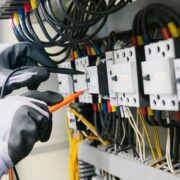
A dry basement is more than a comfort; it protects your home’s structure and your health. That’s why the sump pump is such an important part of any home’s waterproofing system. Designed to prevent flooding and excess moisture, a sump pump requires consistent maintenance to function properly when you need it most.
For homeowners who rely on a sump pump to protect their foundation, routine maintenance is non-negotiable. Small issues that go unnoticed can turn into major water damage during a storm. Understanding how to maintain a Canton sump pump ensures your system stays reliable year-round and protects your investment.
What Is a Sump Pump?
A sump pump is a small device installed in the lowest part of your basement or crawl space, typically inside a pit. When water enters the pit, the pump activates and channels the water away from your home through a discharge pipe. These devices are essential in areas prone to flooding or where the water table is high.
There are two main types of sump pumps: pedestal and submersible. Pedestal models have motors mounted above the water line, while submersible ones sit inside the pit. Regardless of the type, both require the same level of attention and care.
Why Maintenance Is Critical
A sump pump only runs under specific conditions, typically during heavy rain or rapid snowmelt, allowing it to sit idle for extended periods. Without proper maintenance, parts can corrode or clog, power sources can fail, and the pump may not activate when needed.
Routine upkeep of your sump pump ensures it functions properly during emergencies. Regular checks can identify small problems before they cause flooding, mold growth, or costly foundation damage.
Monthly Checks
Performing a few quick monthly checks can help keep your sump pump in good working condition. Start by pouring a bucket of water into the sump pit. This should trigger the pump automatically. If it does not activate, there may be a problem with the float or electrical system.
Also, inspect the power cord to ensure it is secure and free from wear. Many sump pumps rely on a ground fault circuit interrupter (GFCI) outlet, which can occasionally trip. Test this outlet monthly and reset it if necessary to ensure continuous power.
Quarterly Cleaning
Every three to four months, deeper cleaning is recommended. Begin by unplugging the sump pump and removing it from the pit. Clean the pump inlet screen, which can become clogged with debris such as mud, gravel, or silt. Use a soft brush and water to clear the screen.
Check the discharge pipe and ensure it is not blocked. Sometimes, animals or ice buildup can block the pipe, which prevents water from flowing away from your home. Make sure the pipe is directed away from your foundation and slopes downward.
During this cleaning, also rinse the inside of the pit to remove any standing dirt or buildup that might obstruct the pump.
Annual Inspection
A professional sump pump inspection once a year is always a smart choice. Technicians can evaluate the motor’s condition, test for worn parts, and confirm that the system is capable of handling the expected water volume. They may also test your backup systems, such as a battery-powered unit that operates during power outages.
For homeowners with older systems, an annual inspection may also help determine if it’s time for a replacement. The average lifespan of a sump pump is about 7 to 10 years. Even if the system appears functional, age and wear can compromise its reliability.
Backup Power Systems
Since sump pumps rely on electricity, power outages can leave your home vulnerable during storms. Installing a backup power system, such as a battery-powered or water-powered pump, ensures you’re covered even when the power goes out.
A battery backup kicks in automatically when the main power fails. These units should also be checked regularly and recharged as needed. Some models come with alarms that alert you when the battery is low or malfunctioning.
Signs Your Sump Pump Needs Help
Recognizing the early warning signs of sump pump trouble can prevent major water issues. Here are some things to watch out for:
- Strange noises or vibrations while running
- Frequent cycling on and off, even when dry.
- Water remains in the pit even after the operation.
- Visible rust or corroded parts.
- A constantly tripped breaker.
If you notice any of these problems, don’t wait until the next rainstorm to investigate. Addressing the issue promptly can save your basement and your budget.
Best Practices for Homeowners
Follow these additional tips to extend the life of your sump pump:
- Keep the area around the sump pump clean and free of clutter.
- Avoid dumping chemicals, paint, or cleaning products into the pit.
- Do not rely solely on a single pump if you live in a high-risk flood zone.
- Install a high-water alarm for early flood detection.
Educating your family about the location of the sump pump and what to do in the event of a failure also builds preparedness in emergencies.
Conclusion
Maintaining your sump pump is essential for protecting your home from water damage and foundation issues. From monthly tests to professional annual inspections, small steps go a long way in ensuring your system is ready when it matters most. With careful attention, your sump pump can provide years of reliable service and peace of mind.
If you need expert advice or regular maintenance for your Canton sump pump, contact Canton Foundation Repair Specialists. Our experienced team helps ensure your system runs smoothly and your home stays dry, regardless of the weather.











